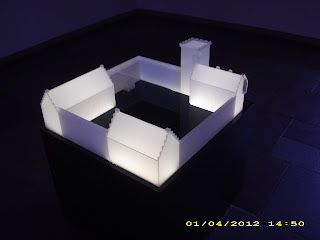
Throughout the castle, they had little models of the castle at various stages of development.
As I have pointed out before, Helsingør is very close to Sweden. The Danes and the Swedes often didn't get along well and, in 1658, the Swedes sacked Helsingør, taking most of their good stuff. At Kronborg, they have a fair number of displays with replicas or artistic renderings of cool stuff that used to be at the castle but which the Swedes now have. Jael and I were starting to think that we needed to head over to the Swedish side, just to see all of the cool stuff.
The original fountain on which this model was based was taken by the Swedes. Doesn't that just seem like an awful lot of work, disassembling and transporting a giant marble fountain? Maybe I'm just not cut out to follow on the rampaging heels of my forefathers but it just doesn't seem worth the bother, even for such a pretty fountain.
One thing that was particular interesting about this fountain, though, is the little armed figures on the edge of the fountain. They alternate holding rifles and bows and arrows which is a really fun snap-shot of the technological changes in warfare that were going on at the time.


A lot of the castle was empty. Just big rooms with paintings or informational plaques on the wall. Part of this was because they were doing renovation in some places. A lot of it, as signs kept reiterating, was because of those pesky Swedes.
They did have a lot of scale models and model doll castles, showing what things would have looked like (if those rotten Swedes hadn't come around). Since the castle was also not well lit, many of my pictures ended up looking really blurry but I will included them anyways because otherwise it would be to much work to describe everything. I expect that the Swedes took all of the good lamps. Lousy Swedes.
 |
| The Kronborg Castle kitchens--how they would have looked if the Swedes hadn't come and if they were having a party. |
 |
| Royal apartments, Kronborg Castle |
 |
| There were a lot of life-sized shadow shows. This one shows servants in the kitchen making a meal. |
One of the big prizes of the Kronborg collection is the Danish Kings series of tapestries. Denmark has the oldest royal family in the world (or the oldest continual monarchy, I am not exactly sure, but they are really proud of it). There were originally 40 tapestries but only 14 are still around and Kronborg has got 7 of them. The tapestries showed 113 Danish kings. The Swedes were planning their own series at the same time and they claimed to have 143 kings to put up but that was because they claimed Noah as the founding Swedish king. (Those Swedes.) You can read a bit about the tapestries here.
 |
| This is King Oluf. He wasn't that spectacular (because he died as a little child) but he is important because his mother was Margaret. She served as Queen Regent and was so beloved (or at least so competent) that, when her son died and she lost all title to the throne, the Danes kept her on anyways. She served as queen for a pretty long time and, in fact, reigned over a united kingdom of Denmark, Sweden, and Norway. She was the queen around whose story The Copenhagen Connection was woven. |
 |
| In one of the hallways, right next to a privy, there was a display about Early Modern plumbing. There was what appeared to be a pile of coffee grounds at the bottom of the plumbing model |
 |
| Jael was excellent to have around good photo opportunities. |


They do Hamlet at Kronborg Castle a lot. Understandably. They also do a fair number of other Shakespeare plays as well. There are a variety of forms for the plays--some traditional, some ballet, some modern, some really, really weird.


The Castle had its very own chapel which was nice, because we went in there when it was raining. It also had a really pretty organ. This picture was taken by Jael since mine all turned out really blurry. Also, it counts as a picture of me. I am on the left.
The edges of the pews (though very blurry here) were really neat and colorful. They looked a lot like Scandinavian barbarian stuff. In the airport at Copenhagen, there was an art installation with giant faces on the wall that looked (from what I can remember) a lot like this. I wonder if there is some "thing" about them in Denmark.
 |
| The inside courtyard of Kronborg Castle's pretty copper roof. |












No comments:
Post a Comment